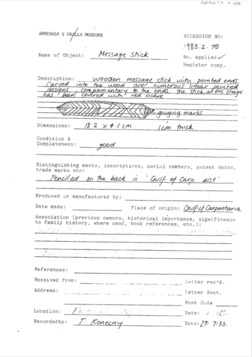UNEMA1983_2_75
Title: A message stick from the Gulf of Carpentaria in the University of New England Antiquities Museum
Description: UNEMA (University of New England Museum of Antiquities) Catalogue data: "Provenance: Central Australia Description: "Two small message sticks with carved decoration" Based on the above 2 points this usually means that nothing else was known about the sticks when the Folk Museum provided them to UNEMA - any info the Folk Museum could provide would have been pasted into the hard file Dated as "Recent" which usually means mid-20th century (ie. not of any antiquity) dimensions: L: 100mm, Diam: 15mm Status: They are a permanent Loan from the Armidale Folk Museum." Armidale Folk Museum register: "Description: wooden message stick with pointed ends. Carved into the wood are numerous linear pointed designs, complementary to the ends. The stick at one stage has been covered with red ochre. [sketch] gouging marks. Dimensions: 18.2 x 4.1cm 1cm thick Condition and completeness: good Distinguishing marks, inscriptions, serial numbers, patent dates, trade marks etc: Penciled on the back is 'Gulf of Carpentaria dist' Place of origin: Gulf of Carpentaria. Recorded by: T. Konecny Date: 29/7/83"
Item type: message stick in a collection
Dimension 1: 182mm Dimension 2: 41mm Dimension 3: 10mm
Institution/Holder file: University of New England Museum of Antiquities (on permanent loan from the Armidale Folk Museum) object identifier: 1983.2.75 (Armidale Folk Museum accession number)
Media copyright: University of New England Museum of Antiquities
Notes: NR wrote to PK on 7 September 2020: "The visual appearance of the UNE message sticks looks very much like the banksia dentate central stem – but that’s a general impression – I can’t claim to be familiar enough with pan-Australian timbers to provide you with the kind of metadata that might assist with provenance." PK replied on 7 September 2020: "The Museum of Antiquities has since retrieved provenance information from a record which simply says: "Central Australia". There is not a particularly strong tradition of message stick use in Central Australia, and if the wood does turn out to be Banksia dentata it would contradict this provenance since this species only grows in the tropics, according to the Atlas of Living Australia." PK's assessment as of 15 September 2021: The UNEMA metadata indicates "Central Australia" but this is contradicted by the register of the Armidale Folk Museum which lists the place of origin for 1983.2.74 as "Western Qld, Boulia?" and the place of origin for 1983.2.75 as "Gulf of Carpentaria dist.[district]". My assessment is that "Central Australia" is wrong. There is no source for this information and it is likely an error that crept in when the objects were loaned to UNEMA. Message sticks are rare in Central Australia. Both objects also appear to have been made from the stem of a Banksia dentata, which does not grow in Central Australia. I'm also sceptical of Western Qld, Boulia. The question mark in the register indicates that this is a guess, and in 1983 the most substantial descriptions of Australian message sticks were objects from Boulia (as described by Walter Roth). My informed guess is that they are both from the Gulf of Carpentaria. They could be compared to the Pitt Rivers Museum object PRM1989_46_8. Based on the distribution of Banksia dentata the materials harvesting for the manufacture of these objects was conceivably Binbinka Country and its vicinity or one of the Wik Countries.
Media Files:
Data Entry: Piers Kelly

